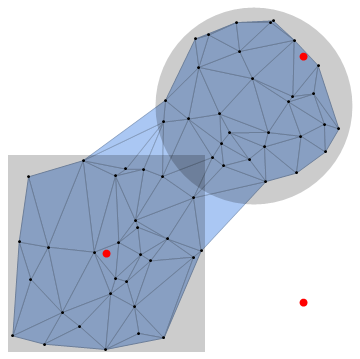I have a data set corresponding to some problem. The data set is just a numerical sampling of $(x,y,z)$ where a particular formula is valid( this thing is analytically intractable that's why I resorted to numerical sampling method). This data set in belongs to a specific volume in the 3-D space. My question is two-fold.
Let's say I have some point $(x1,x2,x3)$; how do I check whether it lies inside the above-said volume or not? Directly checking whether the point lies in the list or not is pointless as the data might have a point $(x1+\epsilon,x2,x3)$ and $(x1-\epsilon,x2,x3)$ but not $(x1,x2,x3)$ exactly.
Is there a way to find the inequality that can approximately define the above-said volume?
As an easy example in 1-D, let's say the data contains (0,.1,.2,...,1), which means the formula is valid from 0 to 1. Now question 1 is asking if .23 lies in the region or not. And the second question for this simple case would be whether I can define the region or not in this case we can see that it can be defined as $0<x<1$.
Edit: Consider a 2-d case. Let say I generate the following list of data
list = Flatten[Table[{x, y}, {x, 0, 1, .1}, {y, 0, 1, .1}], 1]
{{0., 0.}, {0., 0.1}, {0., 0.2}, {0., 0.3}, {0., 0.4}, {0., 0.5}, {0.,
0.6}, {0., 0.7}, {0., 0.8}, {0., 0.9}, {0., 1.}, {0.1, 0.}, {0.1,
0.1}, {0.1, 0.2}, {0.1, 0.3}, {0.1, 0.4}, {0.1, 0.5}, {0.1,
0.6}, {0.1, 0.7}, {0.1, 0.8}, {0.1, 0.9}, {0.1, 1.}, {0.2,
0.}, {0.2, 0.1}, {0.2, 0.2}, {0.2, 0.3}, {0.2, 0.4}, {0.2,
0.5}, {0.2, 0.6}, {0.2, 0.7}, {0.2, 0.8}, {0.2, 0.9}, {0.2,
1.}, {0.3, 0.}, {0.3, 0.1}, {0.3, 0.2}, {0.3, 0.3}, {0.3,
0.4}, {0.3, 0.5}, {0.3, 0.6}, {0.3, 0.7}, {0.3, 0.8}, {0.3,
0.9}, {0.3, 1.}, {0.4, 0.}, {0.4, 0.1}, {0.4, 0.2}, {0.4,
0.3}, {0.4, 0.4}, {0.4, 0.5}, {0.4, 0.6}, {0.4, 0.7}, {0.4,
0.8}, {0.4, 0.9}, {0.4, 1.}, {0.5, 0.}, {0.5, 0.1}, {0.5,
0.2}, {0.5, 0.3}, {0.5, 0.4}, {0.5, 0.5}, {0.5, 0.6}, {0.5,
0.7}, {0.5, 0.8}, {0.5, 0.9}, {0.5, 1.}, {0.6, 0.}, {0.6,
0.1}, {0.6, 0.2}, {0.6, 0.3}, {0.6, 0.4}, {0.6, 0.5}, {0.6,
0.6}, {0.6, 0.7}, {0.6, 0.8}, {0.6, 0.9}, {0.6, 1.}, {0.7,
0.}, {0.7, 0.1}, {0.7, 0.2}, {0.7, 0.3}, {0.7, 0.4}, {0.7,
0.5}, {0.7, 0.6}, {0.7, 0.7}, {0.7, 0.8}, {0.7, 0.9}, {0.7,
1.}, {0.8, 0.}, {0.8, 0.1}, {0.8, 0.2}, {0.8, 0.3}, {0.8,
0.4}, {0.8, 0.5}, {0.8, 0.6}, {0.8, 0.7}, {0.8, 0.8}, {0.8,
0.9}, {0.8, 1.}, {0.9, 0.}, {0.9, 0.1}, {0.9, 0.2}, {0.9,
0.3}, {0.9, 0.4}, {0.9, 0.5}, {0.9, 0.6}, {0.9, 0.7}, {0.9,
0.8}, {0.9, 0.9}, {0.9, 1.}, {1., 0.}, {1., 0.1}, {1., 0.2}, {1.,
0.3}, {1., 0.4}, {1., 0.5}, {1., 0.6}, {1., 0.7}, {1., 0.8}, {1.,
0.9}, {1., 1.}}
If we see the above data, we see that it lies inside a square of unit length. How do I check now that the point (.92,.95) would lie in the above-defined region?




